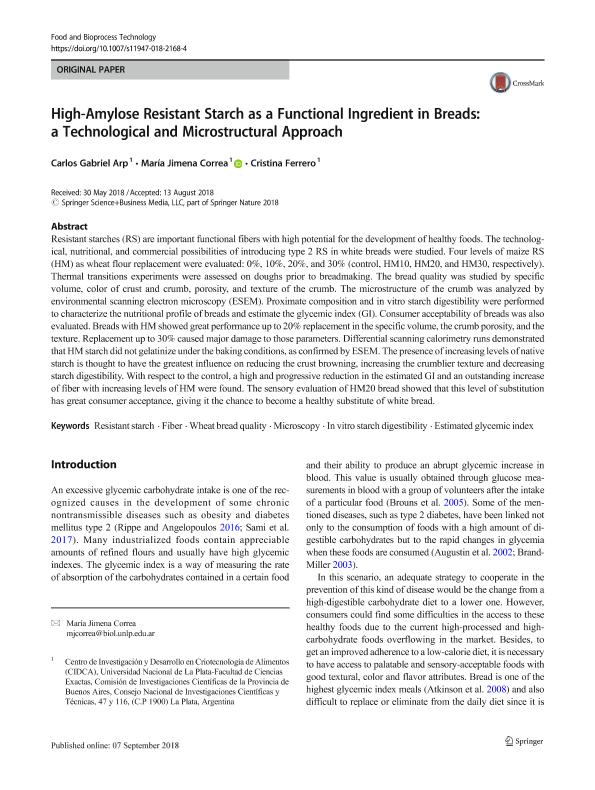Mostrar el registro sencillo del ítem
dc.contributor.author
Arp, Carlos Gabriel

dc.contributor.author
Correa, María Jimena

dc.contributor.author
Ferrero, Cristina

dc.date.available
2019-10-18T17:06:37Z
dc.date.issued
2018-12
dc.identifier.citation
Arp, Carlos Gabriel; Correa, María Jimena; Ferrero, Cristina; High-Amylose resistant starch as a functional ingredient in breads: a technological and microstructural approach; Springer; Food and Bioprocess Technology; 11; 12; 12-2018; 2182-2193
dc.identifier.issn
1935-5130
dc.identifier.uri
http://hdl.handle.net/11336/86383
dc.description.abstract
Resistant starches (RS) are important functional fibers with high potential for the development of healthy foods. The technological, nutritional, and commercial possibilities of introducing type 2 RS in white breads were studied. Four levels of maize RS (HM) as wheat flour replacement were evaluated: 0%, 10%, 20%, and 30% (control, HM10, HM20, and HM30, respectively). Thermal transitions experiments were assessed on doughs prior to breadmaking. The bread quality was studied by specific volume, color of crust and crumb, porosity, and texture of the crumb. The microstructure of the crumb was analyzed by environmental scanning electron microscopy (ESEM). Proximate composition and in vitro starch digestibility were performed to characterize the nutritional profile of breads and estimate the glycemic index (GI). Consumer acceptability of breads was also evaluated. Breads with HM showed great performance up to 20% replacement in the specific volume, the crumb porosity, and the texture. Replacement up to 30% caused major damage to those parameters. Differential scanning calorimetry runs demonstrated that HM starch did not gelatinize under the baking conditions, as confirmed by ESEM. The presence of increasing levels of native starch is thought to have the greatest influence on reducing the crust browning, increasing the crumblier texture and decreasing starch digestibility. With respect to the control, a high and progressive reduction in the estimated GI and an outstanding increase of fiber with increasing levels of HM were found. The sensory evaluation of HM20 bread showed that this level of substitution has great consumer acceptance, giving it the chance to become a healthy substitute of white bread.
dc.format
application/pdf
dc.language.iso
eng
dc.publisher
Springer

dc.rights
info:eu-repo/semantics/openAccess
dc.rights.uri
https://creativecommons.org/licenses/by-nc-sa/2.5/ar/
dc.subject
ESTIMATED GLYCEMIC INDEX
dc.subject
FIBER
dc.subject
IN VITRO STARCH DIGESTIBILITY
dc.subject
MICROSCOPY
dc.subject
RESISTANT STARCH
dc.subject
WHEAT BREAD QUALITY
dc.subject.classification
Alimentos y Bebidas

dc.subject.classification
Otras Ingenierías y Tecnologías

dc.subject.classification
INGENIERÍAS Y TECNOLOGÍAS

dc.title
High-Amylose resistant starch as a functional ingredient in breads: a technological and microstructural approach
dc.type
info:eu-repo/semantics/article
dc.type
info:ar-repo/semantics/artículo
dc.type
info:eu-repo/semantics/publishedVersion
dc.date.updated
2019-10-15T14:10:42Z
dc.identifier.eissn
1935-5149
dc.journal.volume
11
dc.journal.number
12
dc.journal.pagination
2182-2193
dc.journal.pais
Alemania

dc.description.fil
Fil: Arp, Carlos Gabriel. Provincia de Buenos Aires. Gobernación. Comisión de Investigaciones Científicas. Centro de Investigación y Desarrollo en Criotecnología de Alimentos. Consejo Nacional de Investigaciones Científicas y Técnicas. Centro Científico Tecnológico Conicet - La Plata. Centro de Investigación y Desarrollo en Criotecnología de Alimentos. Universidad Nacional de la Plata. Facultad de Ciencias Exactas. Centro de Investigación y Desarrollo en Criotecnología de Alimentos; Argentina
dc.description.fil
Fil: Correa, María Jimena. Provincia de Buenos Aires. Gobernación. Comisión de Investigaciones Científicas. Centro de Investigación y Desarrollo en Criotecnología de Alimentos. Consejo Nacional de Investigaciones Científicas y Técnicas. Centro Científico Tecnológico Conicet - La Plata. Centro de Investigación y Desarrollo en Criotecnología de Alimentos. Universidad Nacional de la Plata. Facultad de Ciencias Exactas. Centro de Investigación y Desarrollo en Criotecnología de Alimentos; Argentina
dc.description.fil
Fil: Ferrero, Cristina. Provincia de Buenos Aires. Gobernación. Comisión de Investigaciones Científicas. Centro de Investigación y Desarrollo en Criotecnología de Alimentos. Consejo Nacional de Investigaciones Científicas y Técnicas. Centro Científico Tecnológico Conicet - La Plata. Centro de Investigación y Desarrollo en Criotecnología de Alimentos. Universidad Nacional de la Plata. Facultad de Ciencias Exactas. Centro de Investigación y Desarrollo en Criotecnología de Alimentos; Argentina
dc.journal.title
Food and Bioprocess Technology

dc.relation.alternativeid
info:eu-repo/semantics/altIdentifier/doi/http://dx.doi.org/10.1007/s11947-018-2168-4
dc.relation.alternativeid
info:eu-repo/semantics/altIdentifier/url/http://link.springer.com/10.1007/s11947-018-2168-4
Archivos asociados
